

|
Lanciano - Our City of Origin
|
|
|
On a map of Italy, if you place your finger on the city of Rome and draw a line directly across to the other coast, you will probably have your finger close to the city of Lanciano. Travel there takes approximately three hours by car or bus. It is the city where our families originated. What our ancestors saw in this valley was the Adriatic Sea to the east and, to the west, the often snow capped Maiella Mountains. This region of central Italy is called Abruzzo and its people refer to themselves as Abruzzese. |
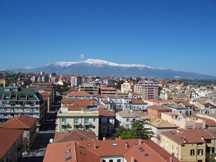 |
|
Lanciano is a city of about 35,000 residents and counts 19 churches / chapels! Its history is long, including a pre-Roman tribe, the Fretani people, then it became a municipality of the Romans, an important trade center during the Middle Ages, it was later controlled by conquering forces of the Spanish and French before the unification of Italy in 1860s. According to tradition, Lanciano is also the birthplace of Longinus, the Roman centurion who thrust his pear into Jesus’ side during the Crucifixion. Lanciano means “of the Spear” in Italian. |
|
|
In the 14th century, Lanciano became the chief town in Abruzzo. It became an important center for market fairs that brought wealth to its citizens. As the population grew, it was necessary to divide the city into districts, these were called quarters (quartiere). Each of the quartiere: Civitanova, Borgo, Sacca and Lancianovecchia have special highlights to see and appreciate. This history is evident in the monuments and architecture to be found in the city. To know more about this place of our ancestors, take the following tour. |
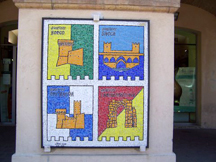 |
|
Lanciano - Visiting the City of our Ancestors
|
|
|
This tour begins in the central square of the older part of Lanciano called Piazza del Plebiscito. Facing the top of the square, we begin by looking at the Lanciano City Hall (municipio), to the right is the Basilica known as Madonna del Ponte and to the left is the monument to the young partisans who resisted the Germans during WWII. The figures represent a mother holding the dying body of her son wounded during the revolt. |
|
 |
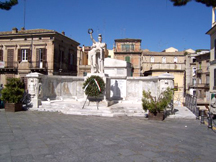 |
|
Lanciano City Hall (municipio)
|
Monument to the Young Partisans
|
|
The first district to be visited is Quartiere Lancianovecchio (old Lanciano) where the ancient fortified center existed before the earthquake in 770 AD. Walking the cobblestone path to the left of city hall, we pass the Teatro Fenaroli with its unique doors and then we move into an area with many medieval structures evident. It was in this area, according to oral tradition, that the earthquake long destroyed much of the city. Its buildings were rebuilt over ruins that can be seen even today. |
|
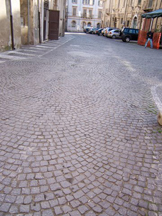 |
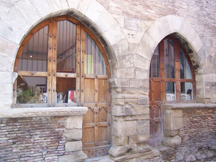 |
| cobblestone path near city hall | Medieval storefronts |
|
This path takes you past the church of S. Agostino where a second Eucharistic miracle is thought to have happened and then past the oldest church in Lanciano, S. Biagio, founded in 1059. Finally we arrive at the only remaining gate of the nine in the old town walls. This 11th century gate opens up to a road to the right leading to the ruins of medieval fortifications. Returning to our starting point, we see to our right the tower and church of Madonna del Ponte. Behind this basilica is the Diocletian Bridge. Built in the 3rd century, during the reign of the Roman ruler Diocletian, it spans the valley below. Its purpose was to connect the plains where the market fairs were held with the city. When the church was constructed, it included a covered walkway over the bridge (ponte) to allow a passageway for its citizens. The passageway is now used for concerts and cultural events because of it excellent acoustic properties. We have completed our tour of the oldest section of Lanciano and now turn our attention to another old quarter. |
|
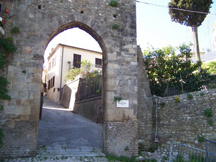 |
 |
| only remaining 11th century gate | Madonna del Ponte (left) // Diocletian bridge (right) |
|
In researching the DellaPietra / LaPietra family tree, it became apparent that most members of this family lived in the quarter known as “Il Borgo”. With the rise in population, the houses of the peasants close to the church of S. Legonziano formed the core of this quarter. In the Piazza Plebiscito, if you turn your back to city hall, you are facing the area of Quartiere Borgo. |
|
| Walking straight ahead, we come to the church of S. Francesco. This site is well known to pilgrims from around the world for the first Eucharistic Miracle that occurred here in the 8th century. It is still possible to view the remains of the body and blood of Christ behind the main altar. Then we take a walk to below the main church to view the original altar where the miracle took place. Tour the ancient rooms below the church that have been converted to venues for concerts and cultural events. | 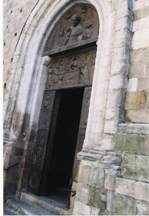 |
|
Once we have exited the church, return to following the street known as Corso Roma and stop at the church of S. Lucia. This is the family parish of the DellaPietra / LaPietra families where they were baptized, married and buried. It was in this church that the oldest records were found giving us the name of our earliest ancestor. Continue up the Corso and turn left to follow the path along the walls and tower of the Aragonese. These were part of the fortifications that were begun in 1480 under Aragonese rule. This massive circular structure of stone is very well preserved. Head back in the direction of the Piazza and to the right you will see Fontana Borgo. This 16th century fountain, interesting for its series of arches, is where the women of Borgo, including members of our families, did their washing. |
|
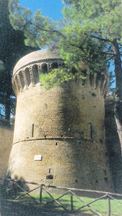 |
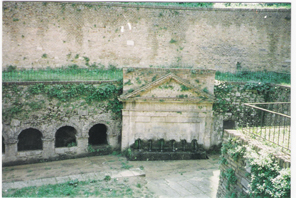 |
| Tower of the Aragonese |
Fontana Borgo
|
|
Return again to the Piazza del Plebiscito and face the monument. This direction leads to the quarters La Sacca and Civitanova. As you bear left, moving past the monument, a set of medieval stairs leads you to a 12th century church built over a temple dedicated to Apollo. It is S. Maria Maggiore (Mary Major), one of the best examples of French Gothic architecture in Abruzzo. This great aisled church leads to a processional cross of gold and silver dating from the year 1421. Notice, too, the massive 12th century doors that grace the front of the church. |
|
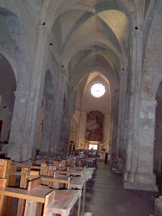 |
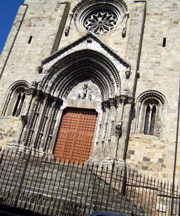 |
|
S. Maria Maggiore
|
S. Maria Maggiore's massive doors
|
|
We are in Quartiere Civitanova (new city). Among the other churches (S. Giovina with a relic of the saint), museums and antiquities found here are the ancient walls, Torri Montanare, that once encircled the city. The great fountain of Civitanova, begun in the 3rd century BC and completed in 18th century is best reached by car. |
 |
|
To see the section known as La Sacca, it is necessary to turn back to the monument on the Piazza and move to your right. In the La Sacca quarter, you find the church of S. Nicola (13th century), the family church for the Nasuti Family and, most likely, where Angela Nasuti LaPietra was baptized. An archaeological museum (Museo Archeologico), the churches of S. Rocco and the Madonna of the Angels, and the ancient Lamaccio bridge are found here. An interesting bit of history is that under the Norman reign, Jews were admitted again to La Sacca in 1191. In Lanciano, eighty familes were let in but confined with many restrictions to the Sacca district. It is still possible to admire some of the little houses of the Middle Ages found here. This completes the tour of the sections of Lanciano most frequently viewed. |
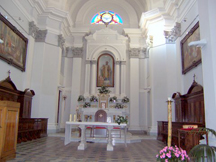 |
|
Were a resident of Lanciano to guide you on a tour of their city, they would certainly show you other interesting places both in the older parts of the city as well as those areas where Lanciano has expanded in the last 200 years. An opportunity, such as this, is the “frosting on the cake” of getting to know the city to which we are all linked by the distant past. |
|
|
Feasts Celebrated in Lanciano
|
|
|
The summer months in Abruzzo come alive with many festivities and celebrations that relive historic traditions or honor the community’s patron saint. This is certainly true in Lanciano where its inhabitants have celebrated feasts for many years. On the last Sunday of August, the Mastrogiurato is commemorated. This is done with colorful medieval costumes, marching drummers, jesters and flag bearers showing off the colors and pride of their district. Each quartiere is represented with a portrayal of life as it was lived in the Middle Ages when fairs were prevalent. The residents re-enact protecting fellow citizens against actors portraying fierce and uncivilized invaders. |
|
|
During the rule of the Angevins in 1300, a powerful political figure was selected to organize the market fairs and to provide security for travelers and traders. Today, this has developed into a prominent member of the community being honored with the title “Mastrogiurato” for the day and he leads the medieval players of each quartiere into the piazza. Music and fireworks conclude the celebration.
|
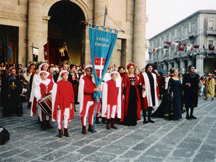 |
|
The feast of Sant’Egidio, a 18th century Benedictine abbot and protector of the disabled and disfigured, is honored on August 31st. A fair takes place and has become a children’s fair with many toy sellers. The feast also occurs in the Piazza del Plebiscite where traditional handmade bells are sold as a love promise between engaged couples. The most cherished feasts among its citizens take place in September. The Nativity of the Blessed Virgin Mary is observed on September 8th. Among the activities is a procession by the women of the town’s four quarters as they carry on their heads typical copper vessels containing seasonal produce. These containers are decorated with colored ribbons and paper flowers. These gifts are offered to their patron at the church of the Madonna del Ponte. From September 14-16 there are additional activities honoring the Madonna. Horse races and fireworks are part of the celebration. |
|
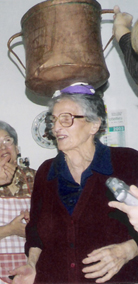 |
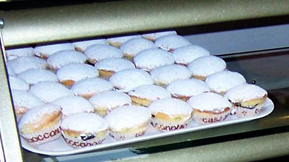 |
|
Aunt Teresa demonstrating how the ladies paraded
with decorated copper vessels |
bocconotto
|
|
Finally, the Frentana Music Summer is an important and loved event in Lanciano. During the summer months, concerts are held during the days and nights with the Diocletian Bridge being the background for the musicians. And while you are enjoying your tours and/or feasts, don’t forget to have the best treat Lanciano can offer. Have a bocconotto, those delicious small tarts found exclusively in this part of Italy. |
|